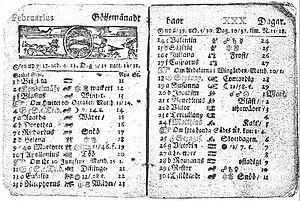This is an old revision of this page, as edited by Kitia (talk | contribs) at 00:19, 1 July 2006. The present address (URL) is a permanent link to this revision, which may differ significantly from the current revision.
Revision as of 00:19, 1 July 2006 by Kitia (talk | contribs)(diff) ← Previous revision | Latest revision (diff) | Newer revision → (diff)
Under the Gregorian calendar, February contains 28 days, or 29 days for a leap year. However, under other calendars there were a few instances of a List of non-standard dates.
Swedish calendar
The Swedish realm (which included Finland at the time) planned to change from the Julian calendar to the Gregorian calendar beginning in 1700 by omitting the leap days for the next 40 years. Thus 1700 was not a leap year in Sweden — but both 1704 and 1708 were leap years, contrary to the plan. This brought the Swedish calendar one day ahead of the Julian calendar but still ten days behind the Gregorian calendar. The Julian calendar was restored when, in 1712, two leap days were added, thus giving that year a List of non-standard dates. That date corresponded to February 29 in Julian and March 11 in Gregorian counting. The Swedish changeover to the Gregorian calendar was finally accomplished in 1753.
Soviet revolutionary calendar
In 1929 the Soviet Union introduced a revolutionary calendar in which every working month had 30 days and the remaining 5 or 6 days were 'monthless' holidays. In this calendar, there existed a List of non-standard dates in the years 1930 and 1931; the revolutionary calendar was abandoned in 1931. However, the Gregorian calendar continued to be used in the Soviet Union during this period. This is confirmed by consulting the successive dates in daily issues of Pravda, the official newspaper of the Communist Party, in which February had 28 days in 1930 and 1931, but had 29 days in 1932, which agrees with the rules of the Gregorian calendar.
Early Julian calendar
The 13th century scholar Sacrobosco claimed that in the Julian calendar February had 30 days in leap years between 45 BC and 8 BC, when Augustus shortened February to give the month of August named after him the same length as the month of July named after his adoptive uncle Julius Caesar. However, all other historical evidence relating to the Julian calendar during this period refutes Sacrobosco, including dual dates with the Alexandrian calendar. See lengths of the months.
Artificial calendars
Artificial calendars may also have thirty February dates. For example, in a climate model the statistics may be simplified by having twelve months of thirty days.
The Hadley Centre GCM is an example.
Reference
- The Oxford Companion to the Year. Bonnie Blackburn & Leofranc Holford-Strevens. Oxford University Press 1999. ISBN 0192142313. Pages 98-99.
External links
- Naturalists Almanac February 30
- 30 days in February 1712
- Change of calendars - Sweden
- Hadley Centre GCM Calendar
January 30 - January 31 - February 28 - February 29 - March 1 - March 30 - March 31
| Months and days of the year | |
|---|---|
| Today: January 14, 2025 [refresh] | |
| January | |
| February | |
| March | |
| April | |
| May | |
| June | |
| July | |
| August | |
| September | |
| October | |
| November | |
| December | |
| |